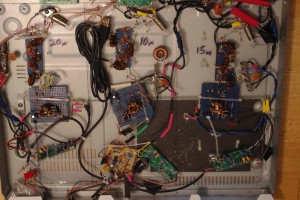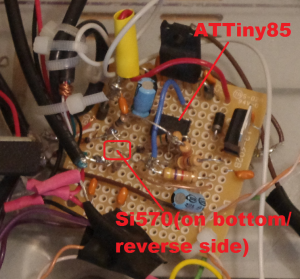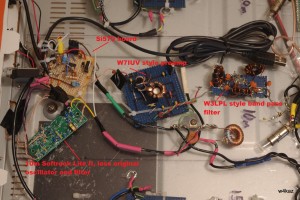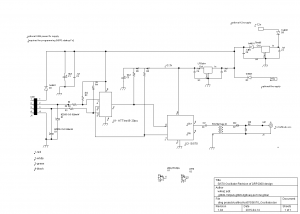Note: More links at bottom of page:  This is a simple-to-build Si570 oscillator for use with the Softrock Lite kits for CW skimmer and input to the Reverse Beacon Network. It uses the Si570 chip and an AtTiny85-20 programmed with the PE0FKO firmware used for the Softrock Ensemble kits.
Currently a programmed ATTiny chip is available separately from K5NWA.  The firmware is available for download, so programming the AtTiny is also an option.  The PE0FKO site also provides the required USB device driver, software, and guidance on using them.  (links)  The Si570 is available from Digikey(digikey part#:336-2518-ND,  manufacturer part:570CAC000141DG).(SiLabs 570CAC000141DG part )
The oscillator itself is pretty simple, and is the bare essential hardware required for re-programming the oscillator for a needed single frequency to use with a Softrock Lite II rx.  It is based on what I saw in the the schematic of the Softrock Ensemble RX, nothing original, just pared down and hijacked from the original Ensemble design.  The Si570 part itself is the bulk of the expense of the oscillator, and the cost of the Si570 chip is almost as much as the Softrock Lite kit itself.   The oscillator signal is fed into the divider through a 10K voltage divider as in the Softrock RX.
So why an Si570 Programmable Oscillator ?
The RX Ensemble kit is a viable alternative expense wise.  It really depends on the intended usage.  Using separate Softrock Lites as single band CW skimmers leads to the choice of a programmable oscillator for customizing the center frequencies, especially for the high bands.  The method used for 20m using the third harmonic seems to result in a decrease in dynamic range.  That results in an increase in false mirror images being reported to RBN by the CW skimmer as actual spots.
Using the Si570, the oscillators can be set at the frequencies needed by the Softrocks, i.e. 4 times the center frequency.  (for 96Khz bandwidth the oscillator would need to be: 20m=56.188, 15m=84.188, and 10m=112.16).  A programmable oscillator also allows switching from 96Khz to 192 Khz bandwidth(20m=56.38,15m=84.38, and 10m=112.38).  Keeping just the bottom half of a 192Khz bandwidth CW skimmer would at a minimum eliminate at least 50% of bad mirror image spots.  There are also likely to be fewer stations CQ’ing below the “.096” section of a band(e.g., most often there is not so much regular CWactivity above 28.096 as there is below).  That is the idea anyway.
The Si570 Programmable Oscillator Prototype:
The first version is deadbugged on a bit of board scrounged from the parts bin. Â Not many parts, but a bit more PCBÂ real estate would have been better. Â Functional rather than esthetic. Â The USB connection is via the usb cable end clipped from an old computer mouse in the parts bin(unlabeled black coil in left of photo). Â Â “Engineer the possible”.
Testing the original prototype board pictured resulted in three build mistakes to debug:  a missing 5v connection to the ATTiny and the reversal in polarity on both zener diodes across the USB data pins.  These mistakes prevented function without damage to the components.  After correction of the build errors the software was able to function with the Si570 as needed for both programming the oscillator(‘startup’) frequency and running as a stand-alone oscillator.
The Si570 when programmed for 112.36Mc was found to have an actual oscillation at close to 28.090 exactly from the Softrock divider, as measured with TS-590 and Elecraft K2.  This was with the oscillator inserted in-circuit as the Softrock Lite oscillator via a transformer(5 bifilar turns on a type 43 torroid core) and a 2.2k resistor.  The frequency is very consistent and stable when the power is cycled on/off.
Setting the frequency is accomplished using either the USB-Sync program by DG8SAQ or via the test program Si570_USB_test from the QRP2000 project from www.sdr-kits.net.  DGF8SAQ’s program is easiest.
Easy measurement of the actual frequency in place is good enough for initial setting up of the skimmer software. A few KC either way will make little difference in a CW skimmer set-up, as final adjustments were done in CW skimmer software to put the skimmer signals ‘on frequency’.  In this case the CW skimmer center frequency is nearly identical to the Si570 programmed frequency.  That has not been the case with the versions using ordinary crystal oscillators, those having a bit more drift off their nominal value.
A new Softrock Lite II is the 10m test bed, with 15m revision to follow. Â These two bands suffer the most from poor dynamic range and false mirror images. Â The 15m oscillator also has a nasty tendency to drift with temperature changes. Â If the modified softrocks perform as desired it will be time to pair these two bands with the best of the sound cards available. Â That will be a separate game of trial and error. Â The 20m softrock skimmer may also be retrofit, as using the third harmonic for the softrock center frequencies seems to adversely impact the dynamic range.
As an aside, the first 10m center frequency chosen was 28.060 into a 192Kc bandwidth sound card. Horrible choice, as it was close enough to the 15m harmonic that interference spikes were present on both bands every 900hz. Â Resetting the Si570 oscillator to place the center Fo for 10m at 28.080 greatly reduced(but not eliminate) the problem. Â Currently set on 28.090 as of 20150414. Â More tinkering required, and migrating the 15m Softrock over to an Si570 oscillator may help.

The current Skimmer package for 20m, 15m and 10m. 20m and 15m will likely be re-worked to use Si570 Programmable Oscillator.
Si570 Programmable Oscillator UPDATE, 2016-11-08
The Si570 oscillator as described was perfectly usable in this application. Â However 10m and 15m performance was was poor on the softrocks, the primary difficulty being a low dynamic range. Â This is indicated by mirror images that appear when SNR values on the actual signals were higher than 35dbSNR.
The most useful work around for this problem is to scan at 192Khz sample rate, and only use the lower half of the sample for the CW skimmer. Â Using the upper 96kc might be easier, as the center frequency could be set at 28.0Mc and 21.0Mc. Â The latter may ulimately be the best approach. Â There are unlikely to be any useful signals below the bottom of the bands, and those could be readily discarded as false or otherwise unusable(i.e., out of band).
LINK LIST, Si570 Programmable Oscillator :
- W4KAZ Schematic
- W4KAZ BareBones Parts List (PDF) (HTML with links)
- KB9YIG Five Dash softrock products page
- K5NWA ATTiny85 page
- PE0FKO Firmware page
- Document:



Leave a Reply